7/10/04 - day 6 |
| View of the ice field |
 |
Since bushwhacking in deadfall spruce sucks, and since we are suckers for great views in this clear weather, we are skirting the Harding ice field as closely as we can. We don't have the skills or equipment to walk on the glaciers, but they are all retreating, and we can walk on their moraines and on overlooking ridges and peaks.
We started the morning with a peak climb, kicking snow steps up to a 5900 foot peak. We were steeply angled and high above the world, and the climb set my vertigo jangling. It's always easier to go up than down on a steep and nerve-racking slope. It's also easier to go up than sideways. So I kicked steps in my diagonally climbing path, completely missing the lower angle traverse below me. It got steeper, and icier, and ended with ice step cutting and mild panic. It wasn't that dangerous, just an open slope to set off my fear of heights. As soon as I set foot on the rocks I swore I was not going to climb any more peaks like that, and as soon as I set foot on the peak I forgot that idea entirely.
| 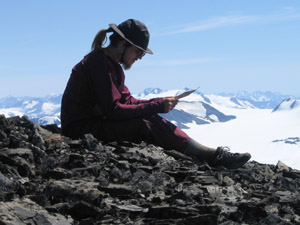 |
|
From the peak we could see the Harding ice field, stretching out as a vast plain of white dotted with only the very peaks of mountains. We could see the first volcanoes of our Alaska Peninsula trek (Redoubt and Iliamna) in the distance across Cook Inlet. We could even see some vague white mounds that must be part of the Alaska Range. It was clear, sunny, breezy, and a stunning panorama all around. |
 |
|
It was the kind of day to make us want to sit and appreciate the view, rather than to push ourselves to get in shape. We came down from our peaks, practicing a bit of glissading along the way, and over the moraine to the Kiley River.
|
 |
|
The first braid channel we waded surprised us with its ferocity, and the last looked impossible. So out came the rafts. Hig wanted to float down the river, rather than just across it, and I agreed to try it if we'd scout the rapids first. Rafting is something I have hard time getting started on. It's fast, and kind of frightening for a coward like me. But once I get going I often enjoy it. Unfortunately the river did little to cooperate with our plans. The first few rapids weren't bad and I was just starting to enjoy myself, rafting a little more continuously, when along came a rather larger than pleasant-looking rapid in a gorge. We got out, but the gorge kept going, complete with rushing rapids and rafter-mocking waterfalls. |
|
Alongside the river we got our closest view yet of a pair of sheep trotting across the snow and keeping a close eye on the intruders in the tundra. We scared up ptarmigans, sending them clucking and flying or running off "wounded" depending on whether they had chicks to hide. We even ran across a couple of the chicks, too young to fly and too young to know to run from intruders. They let us stand close enough to photograph them, and I could have picked one up if I'd wanted to.
|
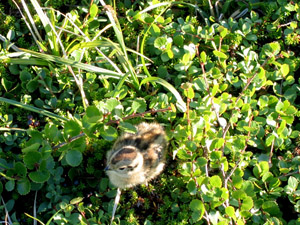 |
 |
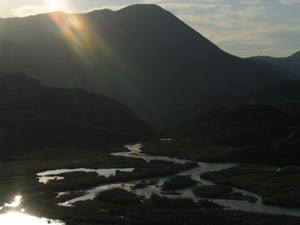 |
|
Tonight we're camping early and tomorrow we have to walk early and long, to push ourselves, and to not fall too far behind our estimated schedule. At this point, we'll probably only walk as far as Homer.
|
|
7/11/04 - day 7 |
| Glacier bagging |
|
Sometimes people go peak bagging when they hike. On this trip we're going glacier bagging. We go right to the edge of each glacier, and around its nose, working our way along the ice field. First it was Skilak Glacier and its icebergs calving into the lake. Then we went over the pass to Kiley Glacier, and today we bagged Indian Glacier. Tonight from our campsite in the pass we can look out upon the even greater expanse of the Tustemena Glacier. It's impressive enough that it even has a state ferry named in its honor.
|
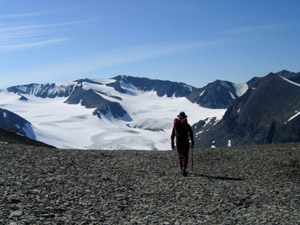 |
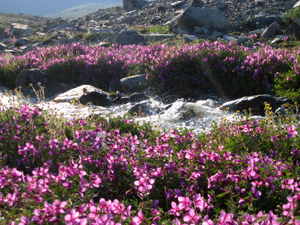 | We need bug netting on the bottom of our sleeping shelter. My writing this trip has been continually distracted by buzzing in my ears, constant monitoring of exposed body parts, and mid-word pauses to slap at the offending insects.
|
|
Today was quite likely one of our hottest days yet, and by unfortunate coincidence was a day we had two climbs over 2000 feet. And my feet and knees are sore to show for it. The sheep trail showed us a way down to Indian Glacier, and I hope we're so lucky tomorrow on our way down from here, which looks on the map to be the most questionable descent of all so far.
Every sensible mammal was taking the heat as a time to rest. The sheep were standing and lying around on a steep slope of scree, noting us, but figuring we weren't worth moving for. The bear looked hot and frustrated as it looked for a good spot to swim the river. |
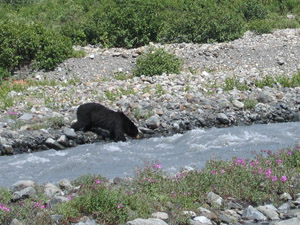 |
 |
We saw it as we paused for a siesta and a hot lunch on Indian Creek, just downstream of the glacier. The wind was blowing strongly down the valley, so the bear couldn't smell us. We were sitting pretty motionless, and he didn't seem to see us either. We watched him pace up and down the rushing glacial river, putting a paw in here and there, not seeming too fond of what he felt there. Finally he just gave up looking and swam across. We stood up when he got to our side, so he could se what we were. And he didn't seem too happy to see us either, since we were standing in the way of the easiest route down the valley. He was a curious black bear, though. He gave us a wide berth, but didn't run. I peered at him through our binoculars, and he kept looking and sniffing right back at me. |
|
I'm impressed by how well bears can swim. We didn't cross that river ourselves, but went over it on a snow bridge by the nose of the glacier, managing both to avoid the crossing and to watch a waterfall splash down into a deep hole in the snow. We couldn't see down to the bottom of the chute. Sprays of water plumed up out of the hole, covering the nearby snow with dirt, and sending two bright bands of rainbow arcing out over the snow.
|
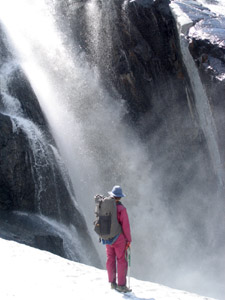 |
 |
|
7/12/04 - day 8 |
| Beached icebergs |
We're camped on the spine of a glacier-polished ridge, looking out over the Tustemena Glacier and a lake of beached icebergs. The icebergs are scattered in a vast pit of dirt and mud, looking lost and incongruous. They were heaped on top of each other in the middle of what once was a lake, and scattered to the edge of what once was as shoreline.
The ice in some of the bergs formed single jigsaw-puzzle-piece shaped crystals as big as your head, crystallized in the depths of the glacier. They cracked and rumbled as they melted, shedding small chunks of ice and dribbling water into the mud. It was one of the most bizarre landscapes I have ever seen.
This area is marked as Arctic Lake on my map, and it must have been a lake quite recently, stranding icebergs which have not yet melted in the summer's heat. We can see old shorelines over a hundred feet above the bottom of the pit. The lake must drain and fill cyclically as it is dammed off by the glacier. I wonder how often it's like this – how unusual a sight we got to see.
|
 |
 |
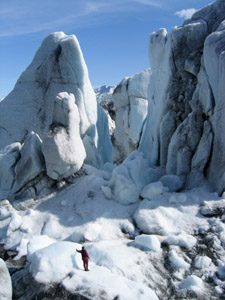 |
 |
|
This day gets high marks for a really cool view, but low marks for overall progress to our goal. I was feeling a bit off all day - low energy and very poky. I guess days like that just happen sometimes. It doesn't help that it's still been quite hot, though I've been able to find the occasional snow patch to fill my hat with.
We chose the only possible way to descend in the steepest part of the slope from our campsite last night. It may not have been the most efficient of plans, and the gully of talus and scree was a difficult descent. But we got down, and managed to cross the river without needing our rafts. Today we left the realm of pure rock and tundra and had to crash through alder and willow patches along our way. They weren't bad, but it was not as nice as before. | 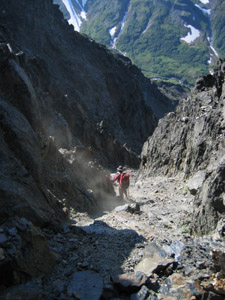 |
 |
When we didn't have willow patches we had some of the most diverse mid-elevation meadows I've seen. There were all sorts of wildflowers, and even some wild onion in bloom. I've never seen wild onion before, but it is an excellent thing to snack on while walking. Ptarmigan food must also be abundant in the meadows, because we saw more ptarmigan there than I think I've ever seen in one place before. Every patch of meadow we stepped in responded with an agitated clucking, a frantic beating of wings, and the flight of a couple ptarmigan parents and a handful of ptarmigan chicks.
But here on our rocky ridge, only sheep come. We saw their trails, we saw a pair of sheep, and we even saw a dead sheep lying untouched on the hillside. Not even the scavengers visit the ridge butting into the glacier. |
|
7/13/04 - day 9 |
| The promise of hell |
|
We're camping in a patch of fireweed a little over an hour into a 5-mile bushwhack that promises to be hellish. We finally left our glaciers for the straightforward route to the ocean. Once we're past this bushwhack we should have only rafting and beach walking to get us to Homer.
We spent most of the day following the Tustemena glacier down to its lake. It's enormous. It's the biggest glacier we've seen yet, though its lake face wasn't as pretty as the lake face of Skilak Glacier. We tromped around in the complicated glacier-side hills of sheep country. We traveled through sheep smell, sheep droppings, sheep piss, sheep trails, and within view of several sheep at times. It was pretty, with a great overview of the glacier, but it was hot.
|
 |
The heat is an almost instant sapper of energy, and as soon as we got any momentum going, we had to stop and cool off. At one point we even stopped to dip ourselves in the water of a murky little ridge top pond, and came away with some little leeches. |
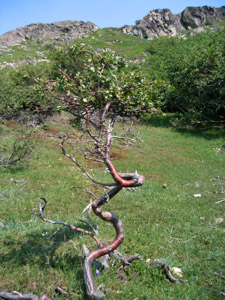 |
 |
At the end of Tustemena Glacier we hopped in the boats and paddled across the lake. I don't know what we would do anymore without boats. The river from the lake at Tustemena Glacier to Tustemena Lake proper was different than any river I've ever rafted down before. It was a normal braided river, just on a much larger scale. The waves were mostly medium sized, continuous and bumpy, but not too bad. And the river was full of what looked to be gravel bars, but all the "gravel" in them was cobble-sized at least, and covered by enough water to easily float the rafts. We shot over gravel bars like little twigs, and got dumped into a few eddy lines large enough to be somewhat unnerving. |
|
At the end of the river we paused for a fire to warm up our glacial-river-soaked bottoms, and to eat an excellent meal of sauteed bolitas mushrooms, wild onion, and dried tomatoes in oil. It was wonderful, and I wish I had more real food like it.
Paddling across Tustemena Lake put me almost back into kayaking mode again, which I was rudely thrust out of by the start of the bushwhack. I hope we can finish this tomorrow. The only good thing I can say for it is that the red currants here are both ripe and excellently tasty. |
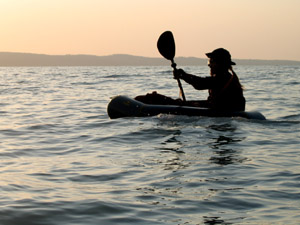 |
|
7/15/04 - day 10+ |
| A long stumble into Homer |
|
Near the end of a trip, destination fever can build to a point where our pace quickens, our breaks drop away, and longer days than would otherwise be possible melt away under our feet. But 23 and a half hours of travel goes far beyond any push to the finish I have made before. We'd been meaning to push ourselves at some point the whole trip, but laziness, heat, and the distraction of hanging out in cool places sapped most of that motivation. But yesterday-today we have done it.
It began with a bushwhack not quite as unpleasant as we had expected. But we were expecting the worst. The spruce deadfall was thick and sharp and treacherous, hiding under grass and alder and piling up into great thickets of spikes. One wrong step sent a foot plunging through brittle-dry branches, scraping the attached leg and body on every broken-off end. The only things happy for the fallen trees were the newly sun-drenched berry bushes, and we had huckleberries and red currants to snack on as we stumbled and tripped. But there were patches of easier going as well, the heat was less oppressive in the brush, and a judicious application of DEET even made the thick clouds of insects tolerable. It took us five more hours to reach the Fox River, and with some patching, I think my rain pants may even recover.
|
 |
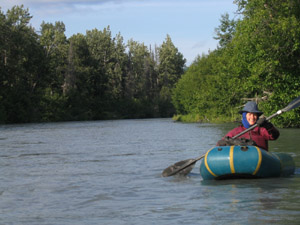 |
So it was only mid-afternoon when we blew up our rafts. The weather was nice, the river was fast, and we thought we might as well just push through the whole length to the ocean. The tall bluffs fringing the river were soft with sand and coal, and nothing in the whole river was big enough to make a rapid. The upper river kept us just at the point of heightened attention, maneuvering into the deep enough channels and around the toppled-over spruce logs. Even beyond the bushwhack, the dead spruce were still trying to shred us. As the river left the bluffs, it slowed, widened a little, and became absolutely brimming with beavers.
Every few minutes we'd jerk to the splash-thump of an irritated beaver, slapping his tail and diving into the stream. Beavers swam down the river in front of us, and their log and tail-dragging trails went everywhere up and down the banks. Some beaver lodges were built right into the banks of the main river, doomed to be washed away in the next spring's floods. Perhaps it is the territory of the new and less-dominant beavers in a crowded beaver world. We confused several moose, browsing on the river banks as these odd-shaped blue puffy animals drifted by. Some ran away, but others just stared at us perplexedly. |
The river slowed and meandered as we approached the ocean, and by the time we hit the tide flats at the head of Kachemak Bay, the sun was already setting. Eagles squealed at us from their driftwood perches, and someone's very incongruous looking cows grazed the tidal grasses. |
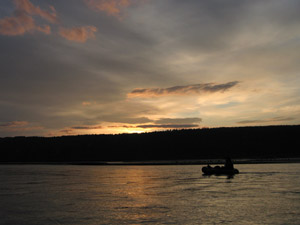 |
 |
|
The last time we were at those tide flats it was on our first wilderness trek four years ago, traveling from Seldovia to Homer. That time we arrived at sunrise, and rafted across the bay with bobbing sea lions. Today the colors came from a dusk instead of a dawn, and we could not see well enough to know whether the slick round heads popping up around us were from seals or sea lions.
We didn't want to stop on the river delta tide flats, even as late as it was, so we set a course for a distant bluff on the Homer beaches. As we paddled, it grew darker and darker. The light wasn't enough to see through anything tricky on land, but it was enough for the water. The lights of a Russian Old Believer village winked on the shore, not seeming to get very much closer as we paddled.
We had no more current to help us, the air was still, and we were left pushing the rafts along at their steady hull speed of two miles and hour. I don't know many songs, at least not in full, but I sang what I knew to keep myself awake. When we stopped for breaks my body quickly chilled, soggy with paddle-dripped water. For almost the first time in ten days, we were dealing not with heat, but with cold.
311 miles of kayaking served me well, and though my mind was tired, my arms dutifully moved the paddle back and forth. It was automatic, and almost easy. Hig was not so lucky, not having had a chance to develop his paddling muscles yet. I prodded us along. As our goal got nearer, the darkness made it less and less distinct, confusing all sense of distance. I tried to teach Hig a song I happened to know all the words to, to keep us both occupied.
And then we landed. We were happy to find it was near high tide, and no endless mudflats awaited us between the water and the shore. It was dark. It was too dark to read my watch, but I estimate now it must have been near to 1 or 1:30 in the morning, near to the 2AM depths of solar midnight.
We were wet and cold, and only the long long beach remained between us and Homer. And we decided to start walking. I figured walking the beach was easy, we wanted to get to Homer early rather than late the next day, and I had a compelling curiosity to see if we could pull it off. Could we just walk all night, not sleep, and reach Homer in the morning? It would be a challenge, and a way to train our minds into the framework I believe we'll need for racing.
On the face of it, putting each foot in front of the other was not terribly difficult. It was an easy beach to walk on, save for an occasional stream to hop or a driftwood tree to clamber over. These small obstacles left me nearly falling on my face, as my tired mind let its sense of balance drift away in the dark. I was still more awake than Hig, and I tried to carry us along, still teaching him the song, trying to keep those few working brain cells we had left occupied.
As if lack of sleep was not enough, we also had not eaten in a long time. We eventually collapsed on a patch of beach, built a quick fire from tinder-dry driftwood, and polished off the last three of our powerbars. Hig slept for 15 or 20 minutes while I poked at the fire to stay warm.
|
|
4 AM. When we left our resting spot the sky was noticeably lighter, and the food seemed to have helped us considerably. I thought the worst of it was over. But Hig could not keep awake on his feet. He stumbled and dragged, and looked so pitifully sleepy that I felt sorry for having dragged him along on this masochistic quest for Homer. He collapsed on the beach for several 5 minute naps, but no nap seemed to help for very long. Finally I suggested that he use his ice axe to stab clamshells as we walked - a game we'd played on the Alaska Peninsula - and that seemed to add the necessary mental spark to keep each foot going in front of the other.
We kept walking. The Homer beaches are straightforward, easy to walk on, and way too long. It was definitely morning now. The birds chirped around us, and the sun lit up the coal-seamed bluffs. Tiredness and hunger vied for the predominant position in our list of complaints, and our little remaining energy flowed and ebbed erratically as we moved along. We took one more five-minute nap, falling instantly into a short deep sleep on a pile of hard gravel. We kept walking.
Finally we left the beach for the road, and both tiredness and hunger gave way to the overwhelming feeling that my feet were about to fall off, explode, or in some other way make their sudden demise. Homer is bigger than it ought to be for its population, and Hig had far underestimated the distance to the airport. Now we trudged on a tiny shoulder next to whizzing cars, feeling each foot wince as it hit the hard ground. I found myself continually thinking we were almost there, and then falling into a rhythm where it seemed as if walking forever was the only thing to do and that it didn't even matter where we were. As we approached the office of Smoky Bay Air, we were speckled with the only few raindrops of the trip.
We chose a cab instead of our feet to bring us to the grocery store, where we earned comments for our bizarre and grubby homemade rain suits, and ate food to bring us back to humanity. From the campsite in the Tustemena bushwhack to the Smoky Bay Air terminal, we traveled for 23 and a half hours, and Hig estimates we went about 40 miles, easily dwarfing much of the rest of our trip.
|
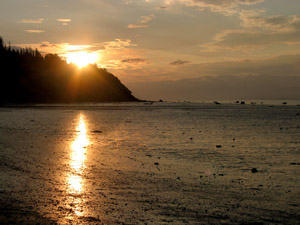 |
|